
Dewick P.M. Medicinal natural products VCH-Wiley, Weinheim, 2002 / booktext@id88013691placeboie
.pdf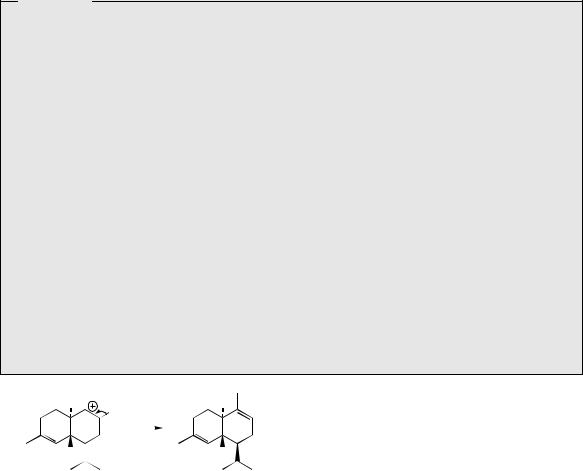
SESQUITERPENES |
197 |
(Continued )
in various European countries to produce the flowerheads, which are then dried for drug use. Volatile oils obtained by steam distillation or solvent extraction are also available.
Roman chamomile is usually taken as an aqueous infusion (chamomile tea) to aid digestion, curb flatulence, etc, but extracts also feature in mouthwashes, shampoos, and many pharmaceutical preparations. It has mild antiseptic and anti-inflammatory properties. The flowerheads yield 0.4–1.5% of volatile oil, which contains over 75% of aliphatic esters of angelic, tiglic, isovaleric, and isobutyric acids (Figure 5.29), products of isoleucine, leucine, and valine metabolism (see pages 100, 295, 306), with small amounts of monoterpenes and sesquiterpenes. Matricaria is also used as a digestive aid, but is mainly employed for its anti-inflammatory and spasmolytic properties. Extracts or the volatile oil find use in creams and ointments to treat inflammatory skin conditions, and as an antibacterial and antifungal agent. Taken internally, matricaria may help in the control of gastric ulcers. The flowers yield 0.5–1.5% volatile oil containing the sesquiterpenes α-bisabolol (10–25%), bisabolol oxides A and B (10–25%) (Figure 5.28), and chamazulene (0–15%) (Figure 5.32). Chamazulene is a thermal decomposition product from matricin, and is responsible for the dark blue coloration of the oil (Roman chamomile oil contains only trace amounts of chamazulene). α-Bisabolol has some anti-inflammatory, antibacterial, and ulcer-protective properties, but chamazulene is probably a major contributor to the anti-inflammatory activity of matricaria preparations. It has been found to block the cyclooxygenase enzyme in prostaglandin biosynthesis (see page 55) and the anti-inflammatory activity may result from the subsequent inhibition of leukotriene formation.
H |
|
|
H |
|
H |
||
H |
|
|
H |
|
|
||
cadinyl cation |
|
|
α-cadinene |
|
Figure 5.33 |
||
one of the many terpenoids found in juniper berries (Juniperus communis; Cupressaceae) used in making gin, and this compound is derived from the ten-carbon ring-containing cis-germacryl cation. The double bonds in the cis-germacryl cation are unfavourably placed for a cyclization reaction as observed with the germacryl cation, and available evidence points to an initial 1,3-shift of hydride to the isopropyl side-chain generating a new cation, and thus allowing cyclization (Figure 5.27). Amorpha-4,11-diene (Figure 5.34) is structurally related to α-cadinene, but the dif-
ferent |
stereochemistry of |
ring fusion |
and site |
||
of |
the |
second |
double bond is a consequence |
||
of |
a different |
cyclization |
mechanism |
operating |
|
to produce the decalin ring system. In this case, a six-membered ring is most likely formed first giving the bisabolyl cation, and, again, a 1,3-hydride shift is implicated prior to forming the decalin system (Figure 5.27). Amorpha- 4,11-diene is an intermediate in the pathway leading to artemisinin in Artemisia annua (Compositae/Asteraceae) (Figure 5.34). This proceeds through artemisinic acid and dihydroartemisinic acid via modest oxidation and reduction processes. Dihydroartemisinic acid may be converted chemically into artemisinin by an oxygen-mediated photochemical oxidation under conditions that might normally be present in the plant, suggesting that all further transformations may in fact be non-enzymic. An intermediate in this process also found naturally in A. annua is the hydroperoxide of dihydroartemisinic acid. The further modifications postulated in Figure 5.34 include ring expansion by cleavage of this hydroperoxide and a second oxygen-mediated hydroperoxidation. The 1,2,4-trioxane system in artemisinin can be viewed more simply as a combination of hemiketal, hemiacetal, and lactone functions, and the later stages of the pathway merely reflect their construction. Artemisinin is an important
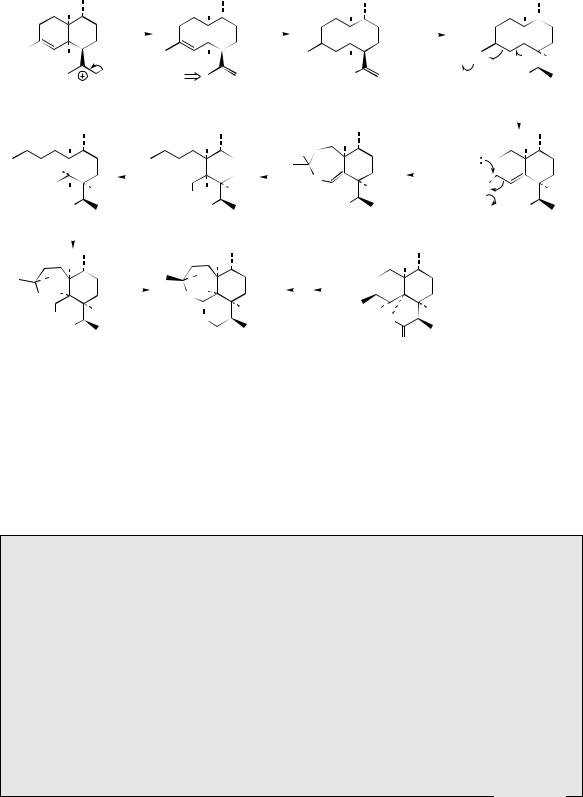
198 |
|
|
|
THE MEVALONATE AND DEOXYXYLULOSE PHOSPHATE PATHWAYS |
|
|
|
|
|||||||||||||||||||||||||||
|
|
H |
|
|
|
|
|
|
|
|
H |
|
|
|
|
|
|
|
|
H |
|
|
|
photoxidation to |
|||||||||||
|
|
|
|
|
|
|
|
|
|
|
|
|
|
|
|
|
|
|
|
|
hydroperoxide |
|
H |
||||||||||||
|
|
|
|
|
|
|
|
|
|
|
|
|
|
|
|
|
|
|
|
|
|
|
|
|
|
|
|
|
|||||||
|
|
H |
|
|
|
|
|
|
|
|
H |
|
|
|
|
|
|
|
|
H |
|
|
|
|
|
O |
|
O |
|
|
|
||||
|
|
|
|
|
|
|
|
|
|
|
|
|
|
|
|
|
|
|
|
|
|
|
|
|
|
|
|
||||||||
|
|
|
|
|
|
|
|
|
|
|
|
|
|
|
|
|
|
|
|
|
|
|
|
|
|
|
|
||||||||
|
|
H |
|
|
|
|
|
|
|
|
H H |
||||||||||||||||||||||||
|
|
|
|
|
|
|
|
|
|||||||||||||||||||||||||||
|
|
|
|
|
|
|
|
|
|||||||||||||||||||||||||||
|
|
|
|
|
O |
|
|
|
|
|
|
|
HO2C |
|
|
|
|
|
|
|
|
|
|
HO2C |
|||||||||||
|
|
|
|
|
|
|
|
|
|
|
|
|
|
|
|
|
|
|
|
|
|
|
|
|
|
|
|||||||||
|
from bisabolyl cation |
|
amorpha-4,11-diene |
|
|
|
|
|
artemisinic acid |
|
|
|
|
|
dihydroartemisinic acid |
||||||||||||||||||||
|
(see Figure 5.27) |
|
|
|
|
|
|
|
|
|
|
|
|
|
|
|
|
|
|
|
|
|
|
|
|
|
|
O2 / hν |
|||||||
|
|
|
|
|
|
|
|
|
|
|
|
|
|
|
|
|
|
|
|
|
|
|
|
|
|
|
|||||||||
|
|
|
|
air oxidation to |
|
|
|
|
|
hydrolysis of |
cleavage of hydroperoxide, |
|
|
|
|||||||||||||||||||||
O |
hydroperoxide |
O |
hemiketal |
ring expansion, and |
|
|
|
|
|||||||||||||||||||||||||||
|
|
|
|
|
|
|
|
|
|
|
|
|
H |
quenching of carbocation |
|
|
|
|
|||||||||||||||||
|
|
H |
|
|
|
|
|
|
|
|
H |
|
|
|
|
|
|
|
|
|
|
H |
|||||||||||||
|
|
|
|
|
|
|
|
|
|
|
|
||||||||||||||||||||||||
|
HOO |
|
|
O2 |
|
|
|
|
|
|
|
|
|
HO |
|
|
|
|
|
H2O |
|
|
|
|
|||||||||||
|
|
|
|
|
|
|
|
|
|
|
|
|
|
|
|
|
|
||||||||||||||||||
|
|
|
|
|
|
|
|
|
|
|
|
|
|
|
|
|
|
|
|
|
|
|
|
|
|
||||||||||
|
|
|
|
|
|
|
|
|
|
|
|
|
|
O |
|
|
|
|
|
|
|
|
|
|
|
|
|
||||||||
|
|
|
|
|
|
|
|
|
|
|
|
|
|
|
|
|
|
|
|
H |
|
|
|
|
|
|
O |
|
|
|
|
||||
|
|
|
|
|
|
|
|
|
|
|
|
|
|
|
|
|
|
|
|
|
|
|
|
|
|
|
|||||||||
|
|
|
|
|
|
|
|
|
|
|
|
|
|
|
|
|
|
|
|
|
|
|
|
|
|
|
|
|
|
|
|
|
|||
|
O H |
H |
|
O H H |
|
|
|
|
|
|
|
|
|
|
|
|
H |
||||||||||||||||||
|
|
|
|
|
|
|
|
|
|
|
|
|
|
|
|
|
|
|
|
|
|
|
|||||||||||||
|
|
|
|
|
|
|
|
|
|
|
|
|
|
HO2C |
|
|
|
|
|
|
HO |
|
|
|
|
||||||||||
|
HO2C |
|
|
|
|
|
|
HO2C |
|
|
|
|
|
|
|
|
|
|
|
|
|
|
HO2C |
||||||||||||
|
|
|
|
|
|
|
|
|
|
|
|
|
|
|
|
|
|
|
|
|
|
|
|
||||||||||||
hemiketal |
|
|
|
|
|
|
|
|
|
|
|
|
|
|
|
|
|
|
|
|
|
|
|
|
|
|
dihydroartemisinic acid |
||||||||
|
|
|
|
|
|
|
|
|
|
|
|
|
|
|
|
|
|
|
|
|
|
|
|
|
|
||||||||||
|
|
|
|
|
|
|
|
|
|
|
|
|
|
|
|
|
|
|
|
|
|
|
|
|
|
|
|
|
hydroperoxide |
||||||
formation |
|
|
|
|
|
|
|
|
|
|
|
|
|
|
|
|
|
|
|
|
|
|
|
|
|
|
|
|
|
||||||
|
formation of hemiacetal, then |
|
|
an enzyme preparation |
|
|
|
|
|
|
|
|
|
|
|
|
|
||||||||||||||||||
|
|
|
|
|
|
|
|
|
|
|
|
|
|
|
|
|
|
|
|||||||||||||||||
|
|
H |
lactone |
|
|
|
H |
|
|
has also catalysed this |
|
H |
|
|
|
|
|||||||||||||||||||
|
O |
|
|
|
|
|
|
|
O |
|
|
transformation |
|
|
|
|
|
|
|
|
|
|
|
|
|
||||||||||
|
|
|
|
|
|
|
|
|
|
|
|
|
|
|
|
|
|
|
|
|
|
|
|
|
|
|
|
|
|
|
|
|
|
|
|
|
HO O |
|
|
|
|
|
|
O O |
|
|
|
|
|
|
|
|
|
|
|
|
|
|
|
|
|
|
|
|
|
|
|||||
|
H |
|
H |
? |
|
|
O |
|
|
H |
|
|
|
|
|||||||||||||||||||||
|
|
|
|
|
|
|
|
|
|
|
|
|
|
|
|
|
|||||||||||||||||||
|
O |
|
|
O |
|
|
|
|
|
|
|
|
|
|
|
|
|
|
|||||||||||||||||
|
|
|
|
|
|
|
|
|
|
|
|
|
|
|
|
|
|
O |
|
|
|
|
|||||||||||||
|
HO2C |
|
|
|
|
|
|
|
|
|
|
|
|
|
|
|
|
|
|
|
|
|
|
|
|
|
|
|
|
|
|
|
|
||
|
|
|
|
|
|
|
|
|
|
|
|
|
|
|
|
|
|
|
|
|
|
|
|
|
|
|
|
|
|
|
|
||||
|
|
|
|
|
|
|
|
|
|
|
|
O |
|
|
|
|
|
|
|
|
|
|
O |
|
|
|
|
||||||||
|
|
|
|
|
|
|
|
|
|
artemisinin |
|
|
|
|
|
|
|
|
dihydroarteannuin B |
|
|
|
|
||||||||||||
|
|
|
|
|
|
|
|
|
|
(qinghaosu) |
|
|
|
|
|
|
|
|
|
|
|
|
|
|
|
|
|
|
|
|
|
|
|||
Figure 5.34
antimalarial component in Artemisia annua , a Chinese herbal drug. There is currently strong research effort to produce artemisinin or analogues as new antimalarial drugs, since many of the current drugs have become less satisfactory due to resistance (see quinine, page 362).
The 11-carbon ring of the humulyl carbocation may be retained, as in the formation of humulene (Figure 5.36), or modified to give the caryophyllyl cation containing a nine-membered ring fused to a four-membered ring, as in β- caryophyllene (Figure 5.36). Humulene is found
Artemisia annua and Artemisinin
Artemisia annua (Compositae/Asteraceae) is known as qinghao in Chinese traditional medicine, where it has been used for centuries in the treatment of fevers and malaria. The plant is sometimes called annual or sweet wormwood, and is quite widespread, being found in Europe, North and South America, as well as China. Artemisinin (qinghaosu) (Figure 5.34) was subsequently extracted and shown to be responsible for the antimalarial properties, being an effective blood schizontocide in humans infected with malaria, and showing virtually no toxicity. Malaria is caused by protozoa of the genus Plasmodium, especially P. falciparum, entering the blood system from the salivary glands of mosquitoes, and world-wide is responsible for 2–3 million deaths each year.
Established |
antimalarial drugs such as chloroquine (see |
page 363) are proving less |
||||
effective in |
the treatment of |
malaria due |
to the |
appearance of drug-resistant |
strains |
|
of P. falciparum. Artemisinin |
is currently |
effective |
against |
these drug-resistant |
strains. |
|
(Continues)
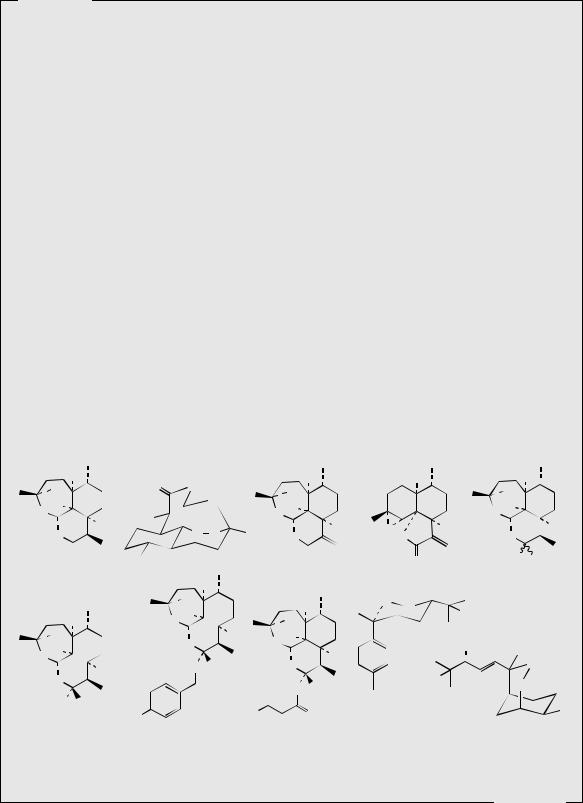
SESQUITERPENES |
199 |
(Continued )
Artemisinin is a sesquiterpene lactone containing a rare peroxide linkage which appears essential for activity. Some plants of Artemisia annua have been found to produce as much as 1% artemisinin, but the yield is normally very much less, typically 0.05–0.2%. Apart from one or two low-yielding species, the compound has not been found in any other species of the genus Artemisia (about 400 species). Small amounts (about 0.01%) of the related peroxide structure artemisitene (Figure 5.35) are also present in A. annua, though this has a lower antimalarial activity. The most abundant sesquiterpenes in the plant are artemisinic acid (arteannuic acid, qinghao acid) (typically 0.2–0.8%) (Figure 5.34), and lesser amounts (0.1%) of arteannuin B (qinghaosu-II) (Figure 5.35). Fortunately, arteannuic acid may be converted chemically into artemisinin by a relatively simple and efficient process. Artemisinin may be reduced to the lactol (hemiacetal) dihydroartemisinin (Figure 5.35), and this has been used for the semisynthesis of a range of analogues, of which the acetals artemether and arteether (Figure 5.35), and the water-soluble sodium salts of artelinic acid and artesunic acid (Figure 5.35), appear very promising antimalarial agents. These materials have increased activity compared with artemisinin and the chances of infection recurring are also reduced. Artemether has rapid action against chloroquinine-resistant P. falciparum malaria, and is currently being used as injection formulations. Arteether has similar activity. Being acetals, artemether and arteether are both extensively decomposed in acidic conditions, but are stable in alkali. The ester artesunic acid is also used in injection form, but is rather unstable in alkaline solution, hydrolysing to dihydroartemisinin. The ether artelinic acid is considerably more stable. These two compounds have a rapid action and particular application in the treatment of potentially fatal cerebral malaria. Dihydroartemisinin is a more active antimalarial than artemisinin and appears to be the main metabolite of these drugs in the body. They rapidly clear the blood of parasites, but do not have a prophylactic effect. Chemically, these agents are quite unlike any other class of current antimalarial agent, and when thoroughly evaluated, they may well become an important group of drugs in the fight against this life-threatening disease.
|
H |
O |
|
O |
|
|
H |
|
H |
|
|
H |
|||
O |
|
O |
O |
|
|
|
O |
||||||||
|
|
|
≡ |
|
|
|
|
|
|
|
|
|
|
||
O O |
|
|
O O |
|
|
|
O O |
||||||||
|
|
|
|
|
|
||||||||||
|
|
H |
|
|
|
O |
O |
|
|
H |
|
O |
H |
|
H |
O |
|
|
|
|
O |
|
O |
|
O |
||||||
|
|
|
|
|
|
|
|
|
|
|
|
|
|
|
H OH |
|
O |
|
|
|
|
|
|
O |
|
O |
|
|
|||
artemisinin |
|
|
|
H |
|
artemisitene |
|
arteannuin B |
|
dihydroartemisinin |
|||||
|
|
|
|
|
|
|
|
|
|
|
|
|
|
|
|
|
|
|
|
|
O |
|
|
H |
|
O |
|
|
|
||
|
|
|
|
|
|
|
|
|
|
O |
|
OH |
|||
|
|
|
|
|
O O |
|
|
|
|
||||||
|
H |
|
|
|
O |
|
|
|
|||||||
|
|
|
|
|
|
|
|
|
|||||||
O |
|
|
|
|
H |
|
|
|
|
|
|
|
|
||
|
|
O |
O O |
|
|
|
OH |
||||||||
|
|
|
|
|
|
|
|
||||||||
O O |
|
|
|
|
|
|
|||||||||
|
|
|
|
|
|
|
H |
|
|
|
|
O |
|||
|
|
H |
|
|
|
O |
H |
O |
|
HO |
|
|
|||
|
|
|
|
|
|
|
|
|
|
|
|
|
|
||
O |
|
|
|
|
|
|
O H |
|
|
|
O |
||||
|
|
|
|
|
|
|
|
|
|
|
|
|
|||
|
|
|
|
|
|
|
|
|
|
|
|
|
|
||
|
H OR |
|
|
|
|
HO2C |
|
|
O |
yingzhaosu C |
|
|
|
||
|
HO2C |
|
|
|
|
|
|
|
|||||||
R = Me, artemether |
|
|
|
|
|
|
|
|
|
||||||
|
|
|
|
|
|
|
|
|
|
|
|||||
R = Et, arteether |
artelinic acid |
|
artesunic acid |
|
|
|
yingzhaosu A |
||||||||
Figure 5.35
(Continues)
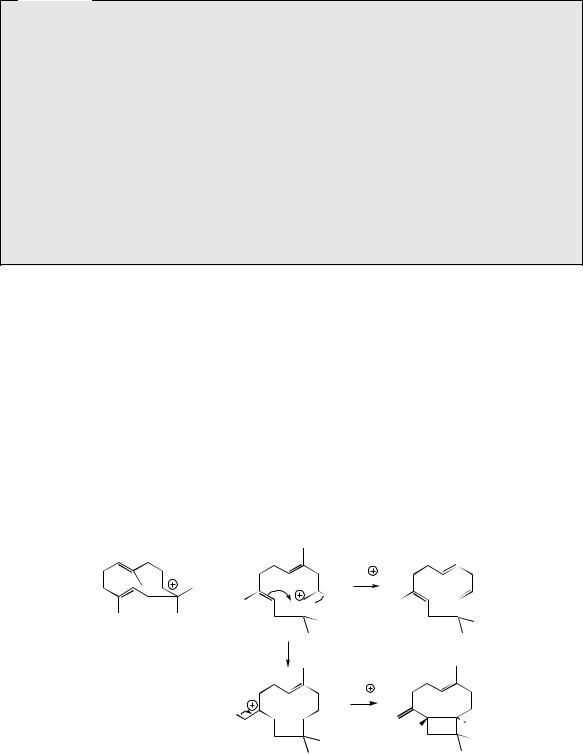
200 |
THE MEVALONATE AND DEOXYXYLULOSE PHOSPHATE PATHWAYS |
(Continued )
The relationship between a peroxide linkage and antimalarial activity is strengthened by the isolation of other sesquiterpene peroxides which have similar levels of activity as artemisinin. Thus, roots of the vine yingzhao (Artabotrys uncinatus; Annonaceae), which is also used as a traditional remedy for malaria, contain the bisabolyl derivatives yingzhaosu A and yingzhaosu C (Figure 5.35), the latter containing an aromatic ring of isoprenoid origin (compare the monoterpenes thymol and carvacrol, page 186). Artemisinin, and other peroxide-containing antimalarial agents, appear to complex with haemin, which is a soluble iron–porphyrin material released from haemoglobin as a result of proteolytic digestion by the malarial parasite. This material is toxic to Plasmodium, so is normally converted into an insoluble non-toxic form haemozoin (malarial pigment) by enzymic polymerization. Agents like chloroquine (see page 363) interfere with the polymerization process. Complexation of haemin with artemisinin by coordination of the peroxide bridge with the iron atom interrupts the detoxification process and leads to the generation of free radical species through homolytic cleavage of the peroxide. The resulting radicals ultimately damage proteins in Plasmodium.
in hops (Humulus lupulus; Cannabaceae), and β- caryophyllene is found in a number of plants, e.g. in the oils from cloves (Syzygium aromaticum; Myrtaceae) and cinnamon (Cinnamomum zeylanicum; Lauraceae).
Gossypol (Figure 5.37) is an interesting and unusual example of a dimeric sesquiterpene in which loss of hydrogen has led to an aromatic system (compare the phenolic monoterpenes thymol and carvacrol, page 186). This material is found in immature flower buds and seeds of the cotton plant (Gossypium species; Malvaceae), though originally isolated in small amounts from cottonseed oil. It can function as a male infertility agent, and is used in China as a male contraceptive. The
cadinyl carbocation via δ-cadinene is involved in generating the basic aromatic sesquiterpene unit hemigossypol, and then dimerization is simply an example of phenolic oxidative coupling ortho to the phenol groups (Figure 5.37).
The formation of sesquiterpenes by a carbocation mechanism means that there is considerable scope for rearrangements of the Wagner– Meerwein type. So far, only occasional hydride migrations have been invoked in rationalizing the examples considered. Obviously, fundamental skeletal rearrangements will broaden the range of natural sesquiterpenes even further. That such processes do occur has been proven beyond doubt by appropriate labelling experiments, and
≡ |
– H |
b |
|
|
a |

 a H
a H
humulyl cation
humulene
b
– H
H
H H
caryophyllyl cation |
β-caryophyllene |
Figure 5.36
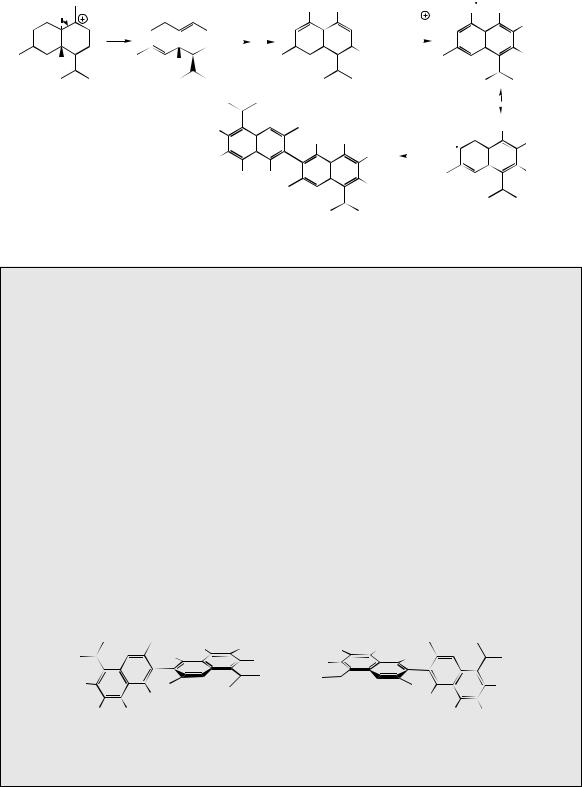
|
|
|
SESQUITERPENES |
|
|
|
|
|
|
|
|
|
201 |
||||||
|
|
|
|
|
|
|
|
|
|
one-electron |
|
|
|||||||
H |
|
various oxidative |
OH |
CHO |
oxidation |
O |
CHO |
||||||||||||
|
processes |
|
|
|
|
|
|||||||||||||
|
|
|
OH |
|
|
– H |
|
|
|
|
OH |
||||||||
|
|
|
|
|
|
|
|
|
|
|
|
|
|
|
|||||
H |
H |
|
|
|
|
|
|
|
OH |
|
|
– e |
|
|
|
|
OH |
||
|
|
|
|
|
|
|
|
|
|
|
|||||||||
|
|
|
|
|
|
|
|
|
|
|
|
|
|
|
|
||||
|
|
|
|
|
|
|
|
|
|
|
|
|
|
|
|
||||
|
|
|
|
|
|
|
|
|
|
|
|
|
|
|
|
|
|
||
cadinyl cation |
δ-cadinene |
|
|
|
|
|
hemigossypol |
|
|
|
|
|
|
|
|
|
|
||
|
|
|
|
|
|
|
|
|
|
radical |
|
|
|
|
|
||||
|
|
|
|
|
|
|
|
|
|
|
|
|
|
|
|||||
|
|
HO |
|
|
|
O |
CHO |
||||||||||||
|
|
|
|
|
coupling |
||||||||||||||
|
|
|
|
|
|
|
OH |
CHO |
|
|
x 2 |
|
|
|
|
OH |
|||
|
|
|
|
|
|
|
|
|
|
|
|
||||||||
|
|
|
|
|
|
|
|
|
|
|
|
||||||||
|
|
|
|
|
|
|
|
|
OH |
|
|
|
|
|
|
|
|||
|
|
HO |
|
|
|
|
|
|
|
|
|
|
|
OH |
|||||
|
|
|
|
|
|
|
|
|
|
|
|
|
|||||||
|
|
|
|
|
|
|
|
|
|
|
|
|
|
||||||
|
|
|
CHO OH |
|
|
|
|
|
|
|
|
|
|
|
|
||||
|
|
|
|
|
OH |
|
|
|
|
|
|
|
|
|
|
||||
|
|
|
|
|
|
|
|
|
|
|
|
|
|
|
|
|
|
|
|
|
|
|
|
|
gossypol |
|
|
|
|
|
|
|
|
resonance forms of free radical |
|||||
Figure 5.37
Gossypol
Gossypol occurs in the seeds of cotton (Gossypium species, e.g. G. hirsutum, G. herbaceum, G. arboreum, G. barbadense; Malvaceae) in amounts of 0.1–0.6%. Its contraceptive effects were discovered when subnormal fertility in some Chinese rural communities was traced back to the presence of gossypol in dietary cottonseed oil. Gossypol acts as a male contraceptive, altering sperm maturation, spermatozoid motility, and inactivation of sperm enzymes necessary for fertilization. Extensive clinical trials in China have shown the antifertility effect is reversible after stopping the treatment provided consumption has not been too prolonged. Cases of irreversible infertility have resulted from longer periods of drug use. The molecule is chiral due to restricted rotation, and can thus exist as two atropisomers which do not easily racemize (Figure 5.38). Only the (−)-isomer is pharmacologically active as a contraceptive, whereas most of the toxic symptoms appear to be associated with the (+)-isomer, which also displays antitumour and antiviral activities. Most species of Gossypium (except G. barbadense) produce gossypol where the (+)-isomer predominates over the (−)-isomer, with amounts varying according to species and cultivar. Racemic (±)-gossypol (but neither of the enantiomers) complexes with acetic acid, so that suitable treatment of cotton seed extracts actually separates the racemate from the excess of (+)-isomer. The racemic form can then be resolved. Other plants in the Gossypieae tribe of the Malvaceae also produce gossypol, with the barks of Thespia populnea (3.3%) and Montezuma speciosissima (6.1%) being particularly rich sources. Unfortunately, gossypol from these is almost entirely the inactive (+)-form.
|
OHC |
OH |
HO |
CHO |
|
|
HO |
OH |
HO |
OH |
|
|
|
|
|
||
HO |
|
|
|
|
OH |
|
OH |
|
|
HO |
|
HO |
CHO |
|
|
OHC |
OH |
|
(+)-gossypol |
|
|
(–)-gossypol |
|
Figure 5.38
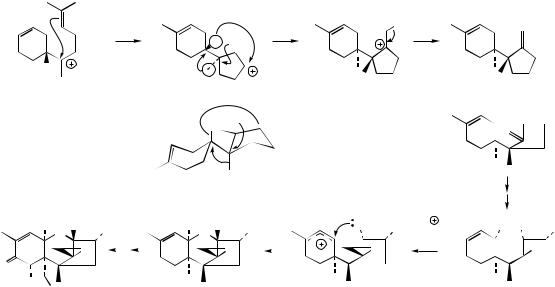
202 |
THE MEVALONATE AND DEOXYXYLULOSE PHOSPHATE PATHWAYS |
a single example will be used as illustration. The trichothecenes are a group of fungal toxins found typically in infected grain foodstuffs. Their name comes from the fungal genus Trichothecium, but most of the known structures are derived from cultures of Fusarium species. A particularly prominent trichothecene contaminant is deoxynivalenol (vomitoxin), which is produced from the less substituted trichothecene isotrichodermol by a sequence of oxygenation reactions (Figure 5.39). The trichothecenes have their origins in nerolidyl diphosphate, and ring closure of the bisabolyl cation derived from it generates a new carbocation with a five-membered ring (Figure 5.39). At this stage, a series of one hydride and two methyl migrations occur to give a cation, which loses a proton to produce the specific trichothecene precursor trichodiene. These migrations are fully backed up by experimental data, and although not immediately predictable, can be rationalized satisfactorily by consideration of the cation suitably bound to the enzyme surface as shown in Figure 5.39. The sequence is initiated by a 1,4-hydride shift which is spatially allowed by the relative proximity of the centres. Two
1,2-methyl shifts then follow, and it is important to note that each migrating group attacks the opposite side of the centre from which the previous group is departing, i.e. inverting the configuration at these centres. Accordingly, a concerted sequence of migrations is feasible, such a process being seen more vividly in the formation of triterpenoids and steroids (see page 216). Loss of a proton and generation of a double bond terminates the process giving trichodiene. Oxygenation of trichodiene gives, in several steps, isotrichotriol. Two of the hydroxylations are at activated allylic positions; hydroxylation on the five-membered ring will therefore occur before the epoxidation. Ether formation, involving perhaps protonation, loss of water and generation of an allylic cation, completes the pathway to the basic trichothecene structure as in isotrichodermol.
Finally, it is worth noting how many of the sesquiterpene derivatives described above are found in plants belonging to the daisy family, the Compositae/Asteraceae. Whilst sesquiterpenes are by no means restricted to this family, the Compositae/Asteraceae undoubtedly provides a very rich source.
electrophilic addition leads to five-membered ring and secondary cation
H
Wagner–Meerwein rearrangements: 1,4-hydride shift; two 1,2-methyl shifts
H 
bisabolyl cation |
≡ |
H
H 


nucleophilic attack of hydroxyl on to allylic cation
H H |
OH |
|
|
H H |
OH |
|
OH |
|||||||
O |
O |
|
O |
|
|
|
|
|||||||
|
|
|
|
|
|
|
|
|||||||
|
|
|
|
|
|
|
|
|
|
|
|
|
|
|
|
|
O |
|
|
|
|
|
|
O |
|
|
|
|
O |
|
|
|
|
|
|
|
||||||||
|
|
|
|
|
|
|
|
|
|
|
||||
|
|
|
|
|
|
|
|
|
|
|
|
|||
O |
|
|
|
|
|
|
|
|
|
|
|
|
||
HO |
|
|
|
|
|
|
|
|
|
|
|
|
||
OH |
|
|
|
|
isotrichodermol |
|
|
allylic cation |
||||||
deoxynivalenol |
|
|
|
|
|
|
|
|
|
|
|
|
||
(DON) |
|
|
|
|
|
|
|
|
|
|
|
|
||
H
trichodiene
≡
sequence of |
|
epoxidation and three |
|
hydroxylations |
O |
|
OH + H |
HO |
OH |
OH |
|
|
– H2O
 O
O
isotrichotriol
Figure 5.39
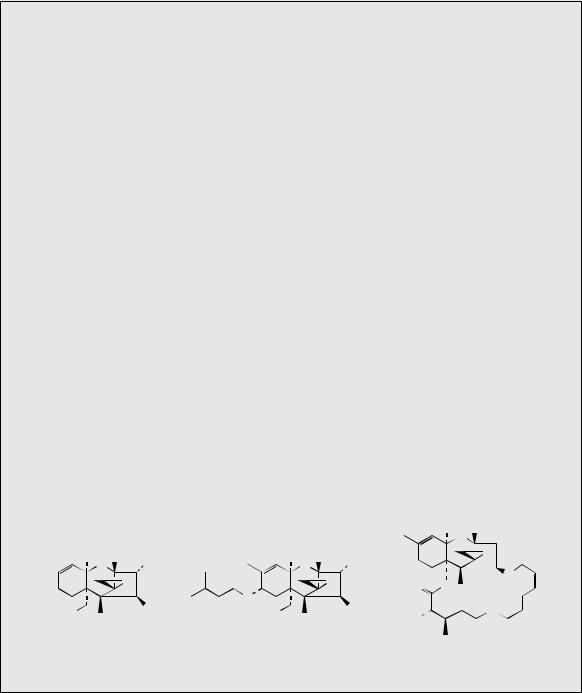
DITERPENES |
203 |
Trichothecenes
The trichothecenes are a group of sesquiterpene toxins produced by several fungi of the genera Fusarium, Myrothecium, Trichothecium, and Trichoderma, which are parasitic on cereals such as maize, wheat, rye, barley, and rice. About 150 different structures have been identified, with some of these being isolated from plants of the genus Baccharis (Compositae/Asteraceae), where a symbiotic plant–fungus relationship may account for their production. Examples of trichothecene structures commonly encountered as food contaminants include deoxynivalenol (DON) (Figure 5.39), and diacetoxyscirpenol (DAS), T-2 toxin, and verrucarin A (Figure 5.40). The double bond and the epoxide group in the basic trichothecene skeleton are essential for toxicity, and the number of oxygen substituents and ester functions also contribute. Macrocyclic ester functions as seen in verrucarin A tend to produce the most toxic examples. Although these compounds are more toxic when injected, oral toxicity is relatively high, and lethal amounts can easily be consumed because of the nature of the host plants. They are sufficiently toxic to warrant routine analysis of foodstuffs such as wheat and flour, and also flour-derived products, e.g. bread, since they survive processing and the high temperatures used in baking. DON levels above 1 ppm are considered hazardous for human consumption. It is relevant to note that when mammals ingest these compounds, a degree of de-epoxidation can occur, ascribed to gut microflora, thus providing some detoxification by removing a structural feature necessary for toxicity.
As their main mechanism of action, these compounds inhibit protein biosynthesis by binding to the ribosome and inhibiting peptidyl transferase activity (see page 407). They also inhibit DNA biosynthesis. A major human condition known to be caused by trichothecenes is alimentary toxic aleukia (ATA), characterized by destruction of the skin, haemorrhaging, inflammation, sepsis, a decrease in red and white blood corpuscles, bone marrow atrophy, and a high mortality rate. A severe outbreak of ATA was recorded in the former Soviet Union shortly after the Second World War when food shortages necessitated the consumption of grain that had overwintered in the field. This had become badly contaminated with Fusarium sporotrichioides and hence T-2 toxin. It is estimated that tens of thousands died as a result.
Many trichothecene derivatives have been tested as potential anticancer agents but have proved too toxic for clinical use.
|
|
|
|
|
|
|
|
H H |
|
|
|
(DAS) |
|
|
|
|
|
|
|
|
|
|
|
|
|
|
|
|
|
|
|
|
|
|
|
|
|
|
|
|
|
|
|
|
|
|
|
|
|
|
|
|
|
|
|
|
|
|
|
|
|
|
|
|
|
|
|
|
|
|
|
|
|
|
|
|
|
|
|
|
|
|
|
|
|
|
|
|
|
|
|
|
|
|
|
verrucarin A |
|
|
|
|
|
|
|
|
|
|
O |
O |
|
|
H H |
OH |
|
H H |
|
OH |
O |
|
|
|
|
O |
O |
|
O |
|
|
O |
|
|
|
|
|
O |
|
|
O |
O |
O |
|
|
|
|
|
|
|
O |
|
|
|
|
|
|
AcO |
|
OAc |
AcO |
|
|
OAc |
O |
|
|
|
|
|
|
|
|
HO |
|
|
|
||
diacetoxyscirpenol |
|
T-2 toxin |
|
|
|
|
||||
|
|
|
O |
|
|
|||||
|
|
|
|
|
|
|
|
|
|
|
Figure 5.40
DITERPENES (C20)
The diterpenes arise from geranylgeranyl diphosphate (GGPP), which is formed by addition of a further IPP molecule to farnesyl diphosphate in the same manner as described for the lower
terpenoids (Figure 5.41). One of the simplest and most important of the diterpenes is phytol (Figure 5.42), a reduced form of geranylgeraniol, which forms the lipophilic side-chain of the chlorophylls, e.g. chlorophyll a (Figure 5.42). Related haem molecules, porphyrin components
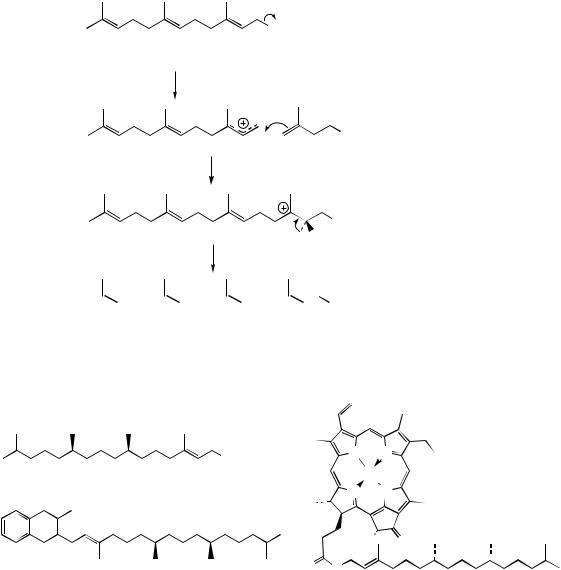
204 |
THE MEVALONATE AND DEOXYXYLULOSE PHOSPHATE PATHWAYS |
OPP
farnesyl PP (FPP)
OPP
allylic cation |
IPP |
electrophilic addition gives tertiary cation
OPP
HR HS
stereospecific loss of proton







 OPP geranylgeranyl PP
OPP geranylgeranyl PP
(GGPP)
Figure 5.41
|
|
|
OH |
N |
N |
|
|
|
Mg2+ |
||
|
|
phytol |
|
||
|
|
|
|
|
|
O |
|
|
N |
N |
|
|
|
|
|
||
|
|
|
|
MeO2C |
O |
|
|
|
|
||
|
|
|
|
||
|
|
|
|
||
|
|
|
|
||
|
|
|
|
|
|
O |
|
|
|
|
|
O |
O |
|
vitamin K1 |
chlorophyll a |
|
(phylloquinone) |
||
|
Figure 5.42
of haemoglobin, lack such lipophilic side-chains. Available evidence suggests that geranylgeranyl diphosphate is involved in forming the ester linkage, and the three reduction steps necessary to form the phytol ester occur after attachment to the chlorophyll molecule. A phytyl substituent is also found in vitamin K1 (phylloquinone) (Figure 5.42), a naphthoquinone derivative found in plants, though other members of the vitamin K
group (menaquinones) from bacteria have unsaturated terpenoid side-chains of variable length. The phytyl group of phylloquinone is introduced by alkylation of dihydroxynaphthoic acid with phytyl diphosphate and a similar phytylation of homogentisic acid features in the formation of the E group vitamins (tocopherols). These compounds are discussed further under shikimate derivatives (see page 158).
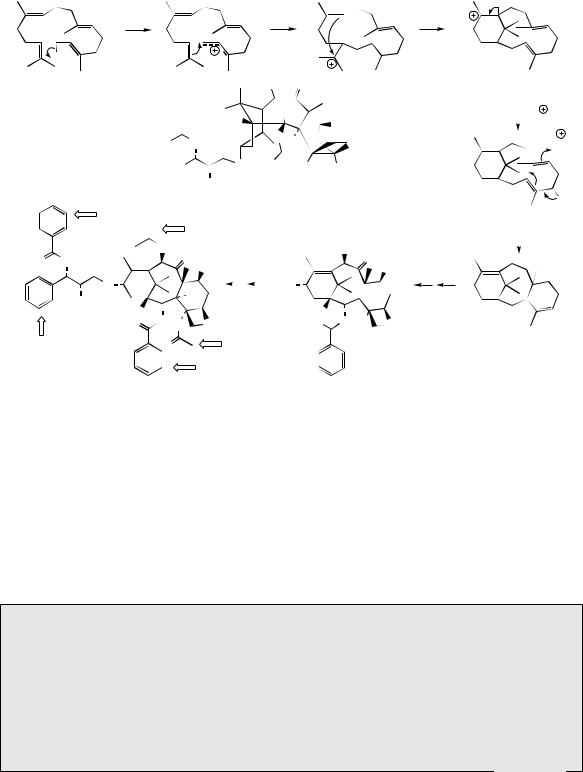
DITERPENES |
|
205 |
|
cyclization by |
|
|
electrophilic addition |
|
E |
giving tertiary cation |
H |
E |
|
|
E |
|
|
|
OPP |
|
|
|
|
|
|
|
|
|
|
|
|
|
|
|
|
||
|
GGPP |
|
|
|
|
|
|
|
|
AcO |
|
|
|
O |
|||||
|
|
|
|
|
|
|
|
|
|
|
|
|
|
|
|||||
|
|
|
|
|
|
O |
|
HO |
|
|
|
|
H |
||||||
|
|
|
|
|
|
|
|
|
|
|
|||||||||
|
|
|
|
|
|
|
|
|
|
O H |
|||||||||
|
|
|
|
|
|
|
|
|
|
|
|
|
|
||||||
|
|
|
|
|
|
|
|
|
|
|
|
|
|
||||||
|
|
|
|
|
Ph |
NH O |
|
|
|||||||||||
|
|
|
|
|
|
Ph |
|
|
O |
|
|
Ph |
|
|
|
O |
|||
|
|
|
|
|
|
|
|
|
|
|
|
||||||||
|
|
|
|
|
|
|
|
|
|
|
|
|
|||||||
|
|
|
|
|
|
|
|
|
|
|
AcO |
||||||||
|
|
|
|
|
|
|
|
OH |
paclitaxel |
||||||||||
|
|
|
|
|
|
|
|
|
|
|
|
|
|
(taxol) |
|||||
|
|
L-Phe |
O |
acetyl-CoA |
|
|
|
|
|
|
|
|
|||||||
|
|
|
|
|
|
|
|
|
|
||||||||||
|
|
|
|
|
|
|
|
|
|
|
|
||||||||
|
|
|
|
|
|
|
|
|
|
|
|
|
|
|
|
||||
|
|
|
|
|
O |
|
several |
|
|
|
|
||||||||
|
|
|
|
|
|
|
|
|
|
||||||||||
O NH O |
|
|
|
O |
|
esterifications |
|||||||||||||
|
|
|
|
|
|
|
|
OH |
|
|
|
|
|
|
|
|
|||
|
|
|
|
|
|
|
|
|
|
|
|
|
|
|
|
||||
|
|
O |
|
|
|
|
|
|
|
|
|
|
|
|
HO |
||||
|
|
|
|
|
H |
|
|
|
|
||||||||||
|
OH |
|
|
|
|
|
|
|
|
|
|
|
|||||||
|
|
|
|
|
|
|
|
|
|
|
|
|
|
|
|
|
|||
|
|
HO |
|
O O |
|
|
|
|
|
|
|
|
|
|
|
HO |
|||
|
|
O |
|
O |
|
|
|
|
|
|
|
O |
|||||||
L-Phe |
|
|
O |
|
acetyl-CoA |
|
|
|
|
||||||||||
|
|
|
|
|
|
|
|
|
|
|
|
|
|
||||||
|
paclitaxel |
|
|
|
|
L-Phe |
|
|
|
|
|
|
|
|
|||||
|
(taxol) |
|
|
|
|
|
|
|
|
|
|
|
|
||||||
|
|
|
|
|
|
|
|
|
|
|
|
|
|
|
|
|
|||
|
verticillyl cation |
|||
|
generation of cation by |
|
|
|
OH |
protonation of alkene; |
|
– H |
|
leads to electrophilic |
|
|
||
|
|
|||
O |
cyclization |
|
H |
|
|
|
|
|
|
H |
|
|
|
|
|
|
|
|
|
|
|
|
|
H |
|
many steps; oxygenation |
verticillene |
||
|
|
|
||
|
of diterpene system and |
|
|
|
OH |
esterifications |
|
|
|
|
|
|||
10 O
OH
 H
H
O  O AcO
O AcO
taxadiene
10-deacetyl- baccatin III
Figure 5.43
Cyclization reactions of GGPP mediated by carbocation formation, plus the potential for Wagner
–Meerwein rearrangements, will allow many structural variants of diterpenoids to be produced. The toxic principle ‘taxine’ from common yew (Taxus baccata; Taxaceae) has been shown to be a mixture of at least eleven compounds based on the taxadiene skeleton which can be readily rationalized as in Figure 5.43, employing the same mechanistic principles as seen with monoand sesqui-terpenes.
Although these compounds are sometimes classified as diterpenoid alkaloids, the nitrogen atom is not incorporated into the diterpene skeleton, as exemplified by taxol (paclitaxel) (Figure 5.43) from Pacific yew (Taxus brevifolia) . The sidechains in taxol containing aromatic rings are derived from shikimate via phenylalanine. Taxol is an important new anticancer agent, with a broad spectrum of activity against some cancers which do not respond to other agents.
Taxus brevifolia and Taxol (Paclitaxel)
A note on nomenclature: the name taxol was given to a diterpene ester with anticancer properties when it was first isolated in 1971 from Taxus brevifolia. When the compound was subsequently exploited commercially as a drug, Taxol was registered as a trademark. Accordingly, the generic name paclitaxel has been assigned to the compound. The literature now contains an unhappy mixture of the two names, though the original name taxol is most often employed.
(Continues)
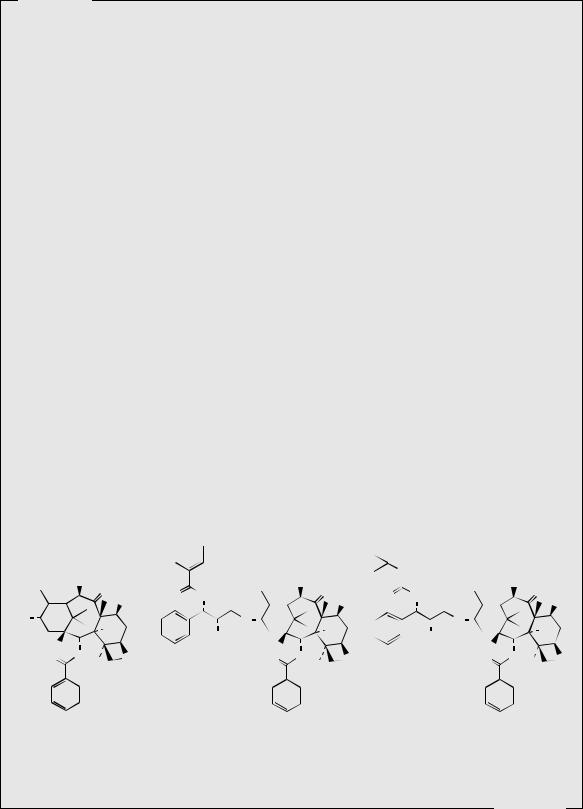
206 |
THE MEVALONATE AND DEOXYXYLULOSE PHOSPHATE PATHWAYS |
(Continued )
The anticancer drug taxol (Figure 5.43) is extracted from the bark of the Pacific yew, Taxus brevifolia (Taxaceae), a slow growing shrub/tree found in the forests of North-West Canada (British Columbia) and the USA (Washington, Oregon, Montana, Idaho, and North California). Although the plant is not rare, it does not form thick populations, and needs to be mature (about 100 years old) to be large enough for exploitation of its bark. The wood of T. brevifolia is not suitable for timber, and in some areas, plants have been systematically destroyed to allow cultivation of faster-growing commercially exploitable conifers. Harvesting is now strictly regulated, but it is realized that this will not provide a satisfactory long term supply of the drug. The bark from about three mature 100-year-old trees is required to provide one gram of taxol, and a course of treatment may need 2 grams of the drug. Current demand for taxol is in the region of 100–200 kg per annum.
All parts of Taxus brevifolia contain a wide range of diterpenoid derivatives termed taxanes, which are structurally related to the toxic constituents found in other Taxus species, e.g. the common yew, Taxus baccata. Over a hundred taxanes have been characterized from various Taxus species, and taxol is a member of a small group of compounds possessing a fourmembered oxetane ring and a complex ester side-chain in their structures, both of which are essential for antitumour activity. Taxol is found predominantly in the bark of T. brevifolia, but in relatively low amounts (about 0.01–0.02%). Up to 0.033% of taxol has been recorded in some samples of leaves and twigs, but generally the taxol content is much lower than in the bark. The content of some other taxane derivatives in the bark is considerably higher, e.g. up to 0.2% baccatin III (Figure 5.44). Other taxane derivatives characterized include 10-deacetyltaxol, 10deacetylbaccatin III, cephalomannine and 10-deacetylcephalomannine. A more satisfactory solution currently exploited for the supply of taxol and derivatives for drug use is to produce these compounds by semi-synthesis from more accessible structurally related materials. Both baccatin III and 10-deacetylbaccatin III (Figure 5.44) have been efficiently transformed into taxol. 10-Deacetylbaccatin III is readily extracted from the leaves and twigs of Taxus baccata, and, although the content is variable, it is generally present at much higher levels (up to 0.2%) than taxol can be found in T. brevifolia. Taxus baccata, the common yew, is widely planted as an ornamental tree in Europe and the USA and is much faster growing than the Pacific yew. Cell cultures of T. baccata also offer excellent potential for production of taxol or 10-deacetylbaccatin III but are not yet economic; taxol yields of up to 0.2% dry weight
|
|
|
OR |
|
|
|
|
|
|
|
OR |
|
|
O |
OH |
|
|||||
|
|
|
O |
|
|
|
|
|
|
O |
|
|
|
|
O |
||||||
|
|
10 |
|
O |
NH |
O |
10 |
|
|
O NH O |
|
|
|||||||||
|
|
|
|
|
OH |
|
|
|
|
OH |
|
|
|
OH |
|||||||
|
|
|
|
|
|
|
|
|
|
|
|
|
|
|
|
|
|
|
|||
HO |
|
|
|
H |
|
OH |
O |
H |
|
|
O |
|
|
H |
|||||||
|
|
|
|
|
|
|
|
|
|
|
OH |
|
|
||||||||
HO |
|
|
|
|
|
|
|
|
|
|
|
||||||||||
|
|
|
|
|
HO |
|
|
|
HO |
|
|
|
|||||||||
O |
|
O |
O |
|
|
|
|
O O |
O |
|
|
O |
O |
O |
|||||||
|
|
|
|
AcO |
|
|
|
|
|
|
|
|
AcO |
|
|
|
|
|
|
AcO |
|
|
|
|
|
|
|
|
|
|
|
|
|
|
|
|
|
||||||
|
|
|
|
|
|
|
|
|
|
|
|
|
|
|
|
|
|
|
|
|
|
R = Ac, |
baccatin III |
|
R = Ac, cephalomannine |
|
|
|
docetaxel |
|
|
|
|||||||||||
R = H, 10-deacetylbaccatin III |
|
R = H, |
10-deacetylcephalomannine |
|
|
(taxotere) |
|
|
|
||||||||||||
Figure 5.44
(Continues)
